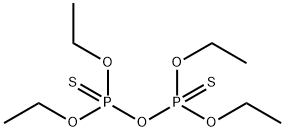Chemical Properties
Yellowliquid. Slightly soluble in water; soluble in most organic
solvents.
Uses
An organophosphate pesticide that is an inhibitor of acetylcholinesterase (AChE).
Uses
Insecticide; miticide.
General Description
Tetraethyl dithiopyrophosphate and compressed gas mixture is a liquid charged with a gas. Tetraethyl dithiopyrophosphate is a yellow liquid. Its vapor is heavier than air. SULFOTEP is lethal by skin absorption and inhalation. Prolonged exposure of the containers to fire or heat may result in their violent rupturing and rocketing.
Reactivity Profile
Organothiophosphates, such as TETRAETHYL DITHIOPYROPHOSPHATE, are susceptible to formation of highly toxic and flammable phosphine gas in the presence of strong reducing agents such as hydrides. Partial oxidation by oxidizing agents may result in the release of toxic phosphorus oxides. SULFOTEP is incompatible with the following: Strong oxidizers, iron [Note: Corrosive to iron.] .
Hazard
Toxic by ingestion, inhalation, and skin
absorption; cholinesterase inhibitor; use may be
restricted. Questionable carcinogen.
Potential Exposure
Sulfotep is used in greenhouse fumigant formulations for control of aphids, spider mites; thrips, whiteflies, etc.
First aid
If this chemical gets into the eyes, remove any contact lenses at once and irrigate immediately for at least 15 minutes, occasionally lifting upper and lower lids. Seek medical attention immediately. If this chemical contacts the skin, remove contaminated clothing and wash immediately with soap and water. Speed in removing material from skin is of extreme importance. Shampoo hair promptly if contaminated. Seek medical attention immediately. If this chemical has been inhaled, remove from exposure, begin rescue breathing (using universal precautions, including resuscitation mask) if breathing has stopped and CPR if heart action has stopped. Transfer promptly to a medical facility. When this chemical has been swallowed, get medical attention. Give large quantities of water and induce vomiting. Do not make an unconscious person vomit. Effects may be delayed. Keep under medical observation.
Shipping
UN1704 (Sulfotep) Tetraethyl dithiopyrophosphate, Hazard Class: 6.1; Labels: 6.1-Poisonous materials.
Incompatibilities
Incompatible with oxidizers (chlorates, nitrates, peroxides, permanganates, perchlorates, chlorine,bromine, fluorine, etc.); contact may cause fires or explosions. Keep away from alkaline materials, strong bases, strong acids, oxoacids, epoxides. Hydrolyzes very slowly in aqueous solution. Attacks some forms of plastic, rubber and coating. Corrosive to iron.
Waste Disposal
Consult with environmental regulatory agencies for guidance on acceptable disposal practices. Generators of waste containing this contaminant (≥100 kg/mo) must conform with EPA regulations governing storage, transportation, treatment, and waste disposal. In accordance with 40CFR165, follow recommendations for the disposal of pesticides and pesticide containers. Must be disposed properly by following package label directions or by contacting your local or federal environmental control agency, or by contacting your regional EPA office. Incineration with added flammable solvent in furnace equipped with afterburner and alkaline scrubber.
Definition
ChEBI: Sulfotep is an organic thiophosphate and an organothiophosphate insecticide. It has a role as an EC 3.1.1.7 (acetylcholinesterase) inhibitor, an EC 3.1.1.8 (cholinesterase) inhibitor, an acaricide and an agrochemical. It is functionally related to a dithiodiphosphoric acid.
Environmental Fate
Soil. Cleavage of the molecule yields diethyl phosphate, monoethyl phosphate and
phosphoric acid (Hartley and Kidd, 1987).
Chemical/Physical. Emits toxic oxides of sulfur and phosphorus oxides when heated
to decomposition (Lewis, 1990).
Metabolic pathway
Sulfotep and related compounds may be formed photochemically from
a number of phosphorodithioate and phosphorothioate insecticides
including azinphos-methyl, chlorpyrifos, malathion, methidathion and
phosalone (Abdelbagi and Gaston, 1998). Since sulfotep has a rather
high mammalian toxicity, this may be of some toxicological sigruficance.
Sulfotep is transformed in the environment via oxidative desulfuration
to the highly active anti-cholinesterase compounds monosulfotep and
tetraethyl pyrophosphate. It is deactivated by hydrolysis to O,O-diethyl
phosphorothioate and diethyl phosphate.
Degradation
Sulfotep is relatively slowly hydrolysed with DT50 values of 10.7,8.2 and
9.1 days at pH values 4,7 and 9 respectively (PM).
Toxicity evaluation
Sulfotep is formulated as fumigant. The
acute oral LD50 for rats is about 10 mg/kg. Inhalation
LC50 (4 h) for rats is about 0.05 mg/L air. NOEL (2 yr)
for rats is 10mg/kg diet (0.5mg/kg/d). ADI is 1 μg/kg
b.w. Sulfotep is activated by oxidative desulfuration to
tetraethyl monothiopyrophosphate and pyrophosphate in
the environment. Sulfotep administered to rats is quickly
eliminated. The major elimination product is diethyl
hydrogen phosphorothioate.
